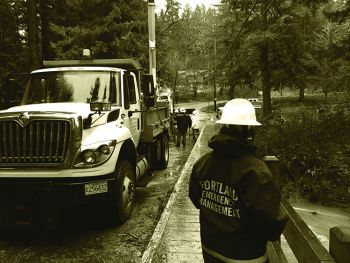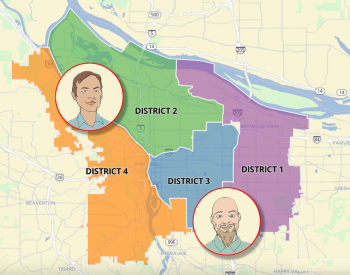Chapter 2: NET Team Leader Basics
The purpose of this chapter is to introduce the basic responsibilities and training of Team Leaders, begin painting a landscape of potential Team Leader resources, and outline what Team Leaders can expect from staff at PBEM. The chapter concludes with a checklist for setting up the Team Leader role.
This chapter does not cover the election or qualifications of Team Leaders. Candidates for a Team Leader position will find those rules in the NET Guidelines.
Chapter 2 learning objectives
- Understand which government rules shape Portland NET.
- Recognize the role of government agencies in what Portland NET does.
- Know who the PBEM Community Preparedness Team is.
- Learn the City of Portland's policies on equity and inclusion.
- Learn what information you'll find on a NET roster.
Governance of Portland NET
City of Portland Codes and Rules
| x | Sidebar: Portland City Code Chapter 3.124.090 | |
The portion of City Code concerning NET Team Leaders reads:
| ||
Portland Fire & Rescue began piloting the NET program in 1994. City Council later created Code governing Portland NET on June 29, 2011. You can view the text of the code that deals specifically with NET Team Leaders in the sidebar to the right.
This part of Portland City Code establishes Portland NET, authorizes the Director of PBEM (or their designee) to define training standards and standards of conduct for NET members, and permits the Director of PBEM to designate specific NET volunteers as "Team Leaders". The code goes on to indemnify NET volunteers as pursuant to Oregon State statute ORS 30.285.
Following from the authority granted in City Code Chapter 3.124.070, the PBEM Director approves and signs the NET Guidelines, a blueprint and catalog of standards for the NET program. NET Team Leaders and PBEM published the first Guidelines on November 19, 2013.
The Guidelines include two particularly important sections for NET Team Leaders. First, Section 600 ("Leadership") describes how a NET elects a Team Leader, how a Team Leader appoints Assistant Team Leaders, and a recommended course of training. This Workbook does not repeat those details here, but Team Leaders are encouraged to familiarize themselves with the NET Guidelines in general and Section 600 in particular.
Second, the PBEM Volunteer Code of Conduct establishes the minimum standards of civility and responsibility PBEM expects from all NET volunteers. Every NET volunteer agrees to and signs the Code of Conduct when they enter Basic NET Training. Because the PBEM Volunteer Code of Conduct references the City's Code of Ethics, volunteers must adhere to both.
NET Team Leaders may think of the Code of Conduct as the minimum standards. NETs may establish further ground rules for their team as long as those additional rules do not contradict the PBEM Volunteer Code of Conduct.
Other Agencies
FEMA, the State of Oregon, Multnomah County, and other government agencies only have small roles to play in Portland NET.
- Though FEMA publishes the CERT curriculum used in NET, FEMA sets no standards or governance for CERT volunteer training. FEMA expects local jurisdictions to manage their own CERT programs, and FEMA does not audit CERT programs. They do provide grant funding that PBEM uses primarily to purchase NET equipment and pay trainers.
- The State of Oregon also has no role managing CERT programs directly. However, as of 2023, Oregon's Office of Emergency Management does coordinate and track CERT programs in the state. There are also state statutes that influence NET programming but are not actively administered.[1]
- Multnomah County supports Portland NET by partnering on grant applications and providing instructor resources and technical support. The County also oversees policy areas such as health and wellness, and mass care and shelter. Multnomah County administers the local Medical Reserve Corps, a team of volunteer medical professionals prepared to respond in a disaster or a major emergency. Finally, Multnomah County has the lead on the Portland area's TeenCERT program in partnership with Portland Public Schools.
Though PBEM interfaces with many other local government agencies (such as Metro or local drainage districts) their activities rarely involve NET directly. Portland Public Schools (PPS) is a noted exception: Portland NET occasionally trains PPS employees in Basic NET and assists with their Youth Disaster Academy program, while PPS provides training space and hosts several BEECNs. Many school administrators also work directly with their local NET on disaster preparedness and response planning.
What to know about PBEM

PBEM has three basic missions: manage Portland's Emergency Operations Center (EOC) and keep it ready for activation, help Portland bureaus plan for a disaster through Continuity of Operations Planning, and promote community resilience. Staff responsible for the third mission are organized into the Community Preparedness Team (CPT). PBEM volunteers such as NETs are most likely to interact with PBEM, and the City of Portland, through the CRT.
As of August 2024, PBEM CRT staff positions most relevant to what NETs do include the following:
- Rachit Nerwal, interim Planning Chief: Rachit supervises the CRT, with Jeremy and Regina as direct reports. Rachit works on broad policy issues and interfaces with other government agencies.
- Regina Ingabire, Community Resilience Outreach Manager: Regina is in charge of Portland's Community Organizations Active in Disaster (COAD) program. Her primary mission is to promote disaster awareness and preparedness among historically underserved communities.
- Jeremy Van Keuren, Community Resilience Manager: Jeremy oversees PBEM volunteer programs, policies, advanced training, and volunteer deployments and operations. Together, Glenn and Jeremy oversee BEECN and NET.
- Glenn Devitt, Neighborhood Emergency Team (NET) Program Specialist: Glenn resolves frontline customer service issues for the CRT (such as badging), coordinates outreach volunteers, and puts together Basic NET classes. Together, Glenn and Jeremy oversee BEECN and NET.
It is not unusual for PBEM volunteers to engage directly with PBEM's Public Information Officer as well, though that position is not allocated to the CRT. The current PBEM PIO is Jaymee Cuti.
All PBEM staff are listed at: https://www.portland.gov/pbem/about-pbem-team
At any given time, many City employees and contractors also support the Community Preparedness Team by undertaking business outreach, conducting research, creating maps, instructing volunteer classes, scheduling venues, designing printed materials, and much more. As a general rule, a NET Team Leader can send any service questions they have to NET@portlandoregon.gov.
PBEM CRT District Liaisons
Every Team Leader has a liaison at PBEM based on which of Portland's four districts their community is in. The PBEM liaison keeps Team Leaders connected to PBEM and other community resilience programs. Liaisons help Team Leaders resolve resource issues, answer questions, and oversee team leader elections.
At present, PBEM has two liaisons:
- Districts 1 and 3: Glenn Devitt (Glenn.Devitt@Portlandoregon.gov)
- Districts 2 and 4: Jeremy Van Keuren (Jeremy.VanKeuren@portlandoregon.gov)

Equity and Inclusion for Portland NET
x
Team Leader team rosters
Team Leaders have access, on request, to their team's roster with important information about each individual volunteer. Team Leaders should never distribute the personal contact information of their team members unless approved by the individual team members themselves. If sharing contact information is necessary to team organization (and it often is), approval can be sufficiently accomplished by emailing all members and asking anyone who doesn't want their information shared with the group to opt out (and give them at least a week to respond).
Data on a roster serves as an important tool for Team Leaders. But, the data is only useful if it is current. Team Leaders should encourage members to keep their profiles up to date and log their volunteer hours. Logging hours also helps the NET program overall, as the quantification of volunteer hours helps PBEM demonstrate the value of the NET program to funders.
A standard roster will include the data fields listed in the table below. PBEM protects the personal data of volunteers carefully. PBEM's policy is only to provide sensitive data fields in a roster (such as address or phone number) on special request, and a Team Leader must justify its use subject to approval of PBEM staff.

Mysterious roster inclusions
It is not uncommon for a Team Leader to receive a roster and see names of members who they've had no contact with. If that happens, the Team Leader should first try to contact the person directly and ask if the member would still like to be a part of NET. If they do not, or if there is some other reason they have not replied (e.g. still in NET but moved to a different neighborhood) the Team Leader should report that information to PBEM staff for record correction.
If there is no reply, the Team Leader should escalate it to PBEM staff. PBEM staff will attempt to contact inside a week or two week time frame. If there is still no response, PBEM will remove the volunteer from active service and the Team Leader should expect not to see that name on future rosters unless the volunteer rejoins.
Notes and References
- ↑ For example: ORS 30.285 and ORS 401.358 to ORS 401.378.
- ↑ PSD file location: S:\3. EMERGENCY OPERATIONS\8. Portland NET\A. ADMINISTRATIVE\A.15 Online Services\A.15.11 HostGator - wiki\Raw Files
- ↑ Jump up to: 3.0 3.1 "Q -" is an internal designation for "Qualification". "'CF -" is an internal designation for "Custom Field".